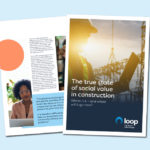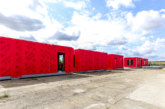More than 100 construction professionals have shared their insight and opinions on social value in the sector in a new white paper launched today.
The report found that more than a decade since the transformative Public Services (Social Value) Act came into force, there still exists a gap between the understanding of social value and its practical application. Delving into the views of respondents – 81% of which are senior management or C-Suite — it’s clear the sector sees access to training and tools to aid accuracy of reporting as a clear path to improvement.
The True State of Social Value in Construction, published by social value experts at Loop, analysed responses from people representing a broad range of construction organisations, spanning SMEs through to large-scale contractors to identify the current preconceptions and understanding of social value — and where improvements could be made.
 Angus Townsend, Director of Social Value at Loop said: “It’s reassuring, especially against a backdrop of the ongoing climate and economic crisis, to see that people are certainly aware of the importance of social value and the part that construction has to play in benefiting its communities.
Angus Townsend, Director of Social Value at Loop said: “It’s reassuring, especially against a backdrop of the ongoing climate and economic crisis, to see that people are certainly aware of the importance of social value and the part that construction has to play in benefiting its communities.
“Construction is certainly one of the more progressive sectors when it comes to social value and understanding its importance. The next part of the journey to really make a difference, however, is organisations needing to consider the impact of their projects from the very start, which can be complicated to get right. It’s not surprising that a majority of respondents (89%) thought that their organisation could do better — implementing any new strategy can take time and requires education and cultural shifts.
“Another positive finding was the fact that 86% of people agree that social value is relevant to procurement, hitting that mark of considering it early on, but only 69% say that it is currently embedded in their process. This highlights the differing maturity curves that have been showcased again and again in our survey, and the stark differences between knowing why it’s important, and being able to put it into practice.”
Identifying the growing prominence of social value, 84% of respondents cited that it is going to become a bigger part of their job role in the future. Training will be key, and 91% of people who received support found it useful. One area to focus on would be raising awareness of monetised proxy values, as 65% stated concerns over monitoring it correctly, without inflating prices or over claiming.
The survey also revealed that no matter the level of understanding or training, there is a huge scope of processes, procedures and platforms being used to measure social value. Only 52% of respondents are already using social value measurement tools, but the scope of techniques ranges from basic spreadsheets to full software offerings.
A move to digital tools can help do the heavy lifting for many, especially SMEs. Four key elements for any such software were cited as user-friendliness and functionality, robustness of metrics, broadness of metrics, and the ability to include bespoke options.
Angus added: “On the face of it, measuring and monitoring social value may seem overwhelming — both understanding how to do so and ensuring there’s enough capacity in teams.
“This is where monetising the impact using proxy financial values can make it seem more tangible and calculating it using specialist tools can help to remove any confusion, doing so with accuracy using quality metrics. Measuring social value means measuring the impact on real lives of real people, and that will never be a finite task, rather an ongoing exercise that will develop in maturity over time.
“Crucially, though, there’s a widespread acceptance within construction professionals across the board that social value is an important part of their role. One of the most heartening statistics from our analysis is the drive for continuous improvement — with the phrases ‘improve’, ‘improvement’, ‘do better’ and ‘do more’ being the most commonly used within responses. The key now will be in taking the right steps to realise its future potential.”









